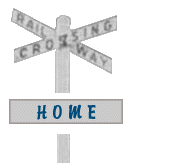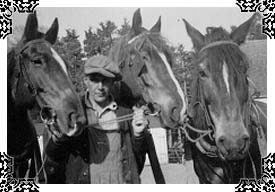








Successful farming meant owning healthy, hard-working livestock. Cattle, pigs, and chickens not only produced the milk, meat, and eggs for the family, but also provided a source of steady income, as these products could be sold to the stores and small factories in town. At one time, horsepower had a literal meaning, and the strength of your horses determined what you could do on your farm. Horse-drawn carts were the only means of transportation and the horses also drew the ploughs that cultivated the land.
 Because
strong animals were so important to the running of the
farm, farmers were always on the lookout for well-bred
specimens, and were willing to pay their neighbors well
for an offshoot of a winning bloodline. If an animal was
good breeding stock, its death or injury could also mean
a great financial blow for the owner. A local story tells
about a farmer who, strapped for cash, decided to hold a
lottery for his best horse. But just before the day of
the draw, the horse fell ill and died. When asked what he
was going to do,
Because
strong animals were so important to the running of the
farm, farmers were always on the lookout for well-bred
specimens, and were willing to pay their neighbors well
for an offshoot of a winning bloodline. If an animal was
good breeding stock, its death or injury could also mean
a great financial blow for the owner. A local story tells
about a farmer who, strapped for cash, decided to hold a
lottery for his best horse. But just before the day of
the draw, the horse fell ill and died. When asked what he
was going to do,  the farmer
replied that there was no problem at all. The only person
who would care, he insisted, would be the person who won
the horse, and he would make certain to return the
winner's money.
the farmer
replied that there was no problem at all. The only person
who would care, he insisted, would be the person who won
the horse, and he would make certain to return the
winner's money.
Most diseases in animals were caused by poor housing and poor diet. Feeding farm animals was always a problem for farmers, especially during the winter months when there was no pasturing. Because of the importance of horses to the maintenance of the farm, they were the best fed of the animals, receiving the valuable black oats and timothy hay. Some farmers insisted that one or two potatoes a day was a good laxative for their steeds. Besides hay and grain, cattle were fed a combination of turnips, fish meal, and bran. Many farms had boiler houses that would cook potatoes to be mashed with grain and fed to pigs. Not even the farm animals on the Island could get away from having potatoes every night! Before the introduction of chicken feed, some farmers baked cakes for their chickens out of cornmeal and eggs.
Just
about every farm on Prince Edward Island had laying hens,
and sold their eggs to obtain disposable income for the
household. In 1913, farmers began to sell eggs to the
government through a new marketing system called 'egg
circles.' After having stamped each egg with their serial
number, they would then ship the eggs off to a central
agency to be marketed. Later, farmers simply began
filling out charts that they would send along inside
their egg cases. Local egg collectors picked up the eggs
once a week and documented how many were being sent.
After these egg circles were dismantled in the 1940s,
local people continued to sell their eggs to Kensington
stores-- such as Mackenzie's
or K. L.
Waite's-- who would then sell the
eggs in bulk to outside markets.
Not everyone, however, relied on government or
business to deliver their farm-fresh eggs. There is a
story told about a local woman who wanted to bring a
crate of eggs to relatives in Boston, but did not want to
pay duty when crossing the American border. When she got
on the train, she simply tucked the crate  of eggs
under her seat and covered it under her voluminous skirt.
Never ones to pry in such places, the American customs
officers did not find the crate, and the woman arrived in
the Boston States with twelve dozen beautiful eggs for
her many relatives there.
of eggs
under her seat and covered it under her voluminous skirt.
Never ones to pry in such places, the American customs
officers did not find the crate, and the woman arrived in
the Boston States with twelve dozen beautiful eggs for
her many relatives there.
